
Vincent Willem van Gogh was a Dutch post-impressionist painter who is among the most famous and influential figures in the history of Western art. In just over a decade, he created about 2,100 artworks, including around 860 oil paintings, most of which date from the last two years of his life. They include landscapes, still lifes, portraits and self-portraits, and are characterised by bold colours and dramatic, impulsive and expressive brushwork that contributed to the foundations of modern art. He was not commercially successful, and his suicide at 37 came after years of mental illness, depression and poverty.

Hoogeveen[ˌɦoːɣəˈveːn](listen) is a municipality and a town in the northeastern Netherlands.

Nuenen is a town in the municipality of Nuenen, Gerwen en Nederwetten in the Netherlands. From 1883 to 1885, Vincent van Gogh lived and worked in Nuenen. In 1944, the town was a battle scene during Operation Market Garden. The local dialect is called Peellands. In 2009, Nuenen had a population of 22,437.
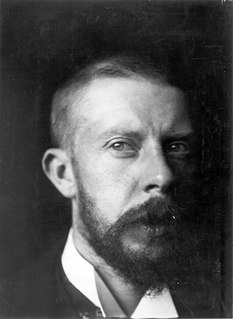
George Hendrik Breitner was a Dutch painter and photographer. An important figure in Amsterdam Impressionism, he is noted especially for his paintings of street scenes and harbours in a realistic style. He painted en plein air, and became interested in photography as a means of documenting street life and atmospheric effects – rainy weather in particular – as reference materials for his paintings.

Anna Rosalie Boch was a Belgian painter, born in Saint-Vaast, Hainaut. Anna Boch died in Ixelles in 1936 and is interred there in the Ixelles Cemetery, Brussels, Belgium.

This is a chronology of the artist Vincent van Gogh. It is based as far as possible on Van Gogh's correspondence. However, it has only been possible to construct the chronology by drawing on additional sources. Most of his letters are not dated and it was only in 1973 that a sufficient dating was established by Jan Hulsker, subsequently revised by Ronald Pickvance and marginally corrected by others. Many other relevant dates in the chronology derive from the biographies of his brother Theo, his uncle and godfather Cent, his friends Émile Bernard and Paul Gauguin, and others.

Nieuw-Amsterdam is a village in the northeast Netherlands, in the Dutch province of Drenthe. It borders the village of Veenoord, the twin village of Nieuw-Amsterdam. Since 1998 Nieuw-Amsterdam and Veenoord are part of the municipality of Emmen.

Lying Cow is the name of two oil paintings created by Vincent van Gogh around 1882 when he was living at The Hague.

Farm with Stacks of Peat is an oil painting created by Vincent van Gogh in October or November 1883, early in his artistic career, and which is now in the collection of the Van Gogh Museum, Amsterdam. It was painted near the village of Nieuw-Amsterdam during the artist's short stay at Drenthe in northern Netherlands.

Marshy Landscape is an oil painting created in 1883 by Vincent van Gogh. From 1883–85, van Gogh lived in Drenthe, a remote district of the Netherlands, flat and riven with canals, a landscape of marsh and mist. Throughout 1883, the artist worked on his series of peasants' cottages, exploring the local terrain of marshes and peat fields, ditches and canals. Like much of his work of this period, Marshy Landscape is rendered with subdued earthy tones, giving the impression of being painted with the very soil itself. Alone in the wilderness, Vincent drew upon the power of nature, the stillness and silence of the marshes inspiring him. He wrote to his brother Theo:
Went further into the peat fields last week — marvellous scenes, the longer I stay here the more beautiful I find it, and from the outset I’ll try to stay here in this region. For it’s so beautiful here that at the same time a great deal of study is needed to capture it, and only solid work can give a truer understanding of things as they are at bottom, and of their serious, sober nature.

Cottages is a subject of paintings created by Vincent van Gogh from 1883 and 1885. This is related to the Peasant Character Studies that Van Gogh worked on during the same time period.

Old Church Tower at Nuenen are names given to several oil paintings and drawings created in 1884 and 1885 by Vincent van Gogh. Most reflect the way the 12th-century church looked in its better days when its spire was intact and its foundation formidable. The spire was demolished in 1792 and the church tower was in the process of being torn down and sold for scrap as Van Gogh made the paintings.

The Parsonage Garden at Nuenen, alternatively named The Parsonage Garden at Nuenen in Spring or Spring Garden, is an early oil painting by 19th-century Dutch post-Impressionist painter Vincent van Gogh, created in May 1884 while he was living with his parents in Nuenen. Van Gogh made several drawings and oil paintings of the surrounding gardens and the garden façade of the parsonage.
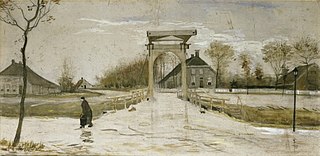
Drawbridge in Nieuw-Amsterdam is a watercolor created in November 1883 by Vincent van Gogh in Drente, The Netherlands.

Peasant Character Studies is a series of works that Vincent van Gogh made between 1881 and 1885.

Vincent van Gogh drew and painted a series of works of his mistress Sien during their time together in the Netherlands. In particular, his drawing Sorrow is widely acknowledged as a masterwork of draftsmanship, the culmination of a long and sometimes uncertain apprenticeship in learning his craft.
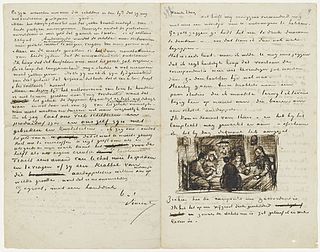
The Letters of Vincent van Gogh refers to a collection of 903 surviving letters written (820) or received (83) by Vincent van Gogh. More than 650 of these were from Vincent to his brother Theo. The collection also includes letters van Gogh wrote to his sister Wil and other relatives, as well as between artists such as Paul Gauguin, Anthon van Rappard and Émile Bernard.
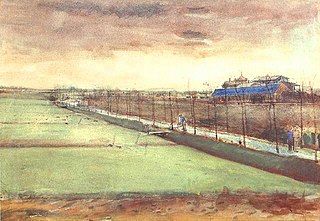
Meadows near Rijswijk and the Schenkweg is a watercolor by the Dutch painter Vincent van Gogh that he made in January 1882, shortly after taking up residence in The Hague.
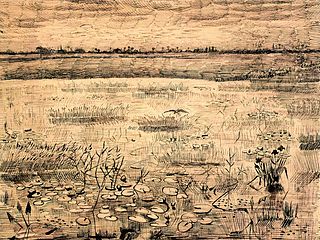
Marsh with Water Lilies is a drawing by Vincent van Gogh. It was executed at Etten in June 1881.

Peasant Woman Digging Up Potatoes is a painting by Vincent van Gogh, probably painted in 1885. It is now in the Royal Museum of Fine Arts, Antwerp. It is oil on canvas mounted on panel.






















